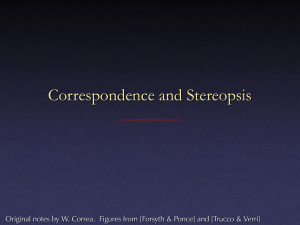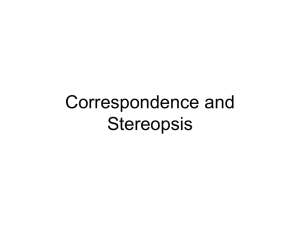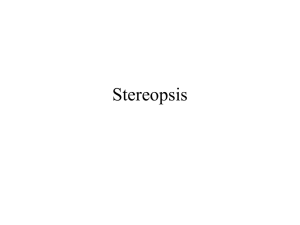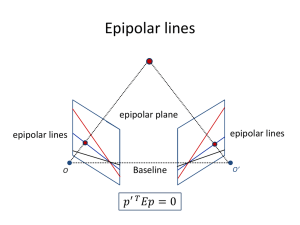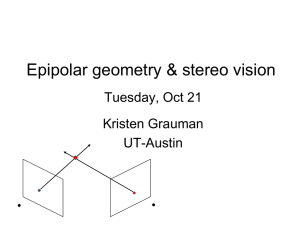Correspondence and Stereopsis
advertisement
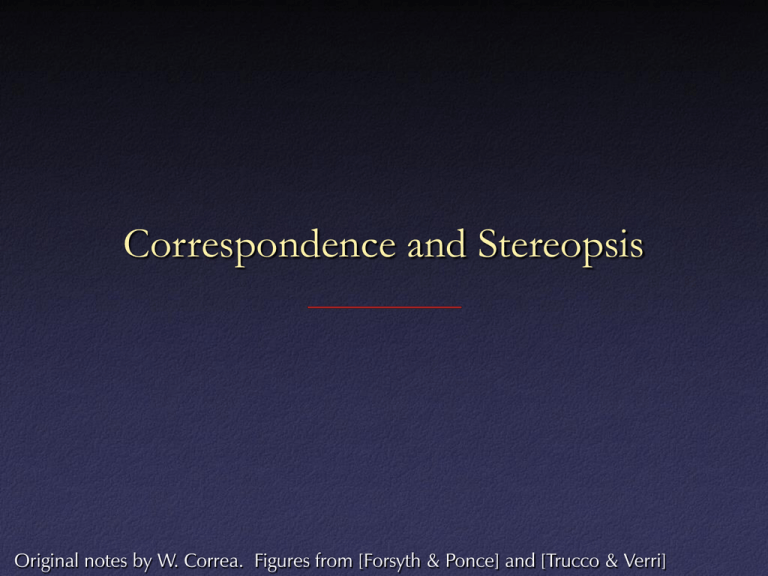
Correspondence and Stereopsis Original notes by W. Correa. Figures from [Forsyth & Ponce] and [Trucco & Verri] Introduction • Disparity: – Informally: difference between two pictures – Allows us to gain a strong sense of depth • Stereopsis: – Ability to perceive depth from disparity • Goal: – Design algorithms that mimic stereopsis Stereo Vision • Two parts – Binocular fusion of features observed by the eyes – Reconstruction of their three-dimensional preimage Stereo Vision – Easy Case • 1 single point being observed – The preimage can be found at the intersection of the rays from the focal points to the image points Stereo Vision – Hard Case • Many points being observed – Need some method to establish correspondences Components of Stereo Vision Systems • Camera calibration: previous lecture • Image rectification: simplifies the search for correspondences • Correspondence: which item in the left image corresponds to which item in the right image • Reconstruction: recovers 3-D information from the 2-D correspondences Epipolar Geometry • Epipolar constraint: corresponding points must lie on conjugate epipolar lines – Search for correspondences becomes a 1-D problem Image Rectification • Warp images such that conjugate epipolar lines become collinear and parallel to u axis Image Rectification (cont.) • Perform by rotating the cameras • Not equivalent to rotating the images • The lines through the centers become parallel to each other, and the epipoles move to infinity Image Rectification (cont.) • Given extrinsic parameters T and R (relative position and orientation of the two cameras) – Rotate the left camera about the projection center so that the the epipolar lines become parallel to the horizontal axis – Apply the same rotation to the right camera – Rotate the right camera by R – Adjust the scale in both camera reference frames Disparity • With rectified images, disparity is just (horizontal) displacement of corresponding features in the two images – Disparity = 0 for distant points – Larger disparity for closer points – Depth of point proportional to 1/disparity Correspondence • Given an element in the left image, find the corresponding element in the right image • Classes of methods – Correlation-based – Feature-based Correlation-Based Correspondence • Input: rectified stereo pair and a point (u,v) in the first image • Method: – Form window of size (2m+1)(2n+1) centered at (u,v) and assemble points into the vector w – For each potential match (u+d,v) in the second image, compute w' and the normalized correlation between w and w‘ Sum of Squared Differences • Recall: SSD for image similarity (u, v) (u v) 2 • Negative sign so that higher values mean greater similarity Normalized Cross-Correlation • Normalize to eliminate brightness sensitivity: (u, v) (u u )(v v ) where u v u average( u ) u standard deviation( u ) • Helps for non-diffuse scenes, can hurt for perfectly diffuse ones Correlation-Based Correspondence (cont.) • Main problem: – Assumes that the observed surface is locally parallel to the two image planes – If not, unequal amounts of foreshortening in images – Alleviate by computing initial disparity, warping the images, iterating • Other problems: – Not robust against noise – Similar pixels may not correspond to physical features Feature-Based Correspondence • Main idea: physically-significant features should be preferred to matches between raw pixel intensities • Instead of correlation-like measures, use a measure of the distance between feature descriptors • Typical features: points, lines, and corners • Example: Marr-Poggio-Grimson algorithm Marr-Poggio-Grimson Algorithm • Convolve images with Laplacian of Gaussian filters with decreasing widths • Find zero crossings of the Laplacian along horizontal scanlines of the filtered images • For each , match zero crossings with same parity and similar orientations in a [–w..w] disparity range, with w 2 2 Marr-Poggio-Grimson Algorithm (cont.) • Use disparities found at larger scales to control eye vergence and cause unmatched regions at smaller scales to come into correspondence Marr-Poggio-Grimson Algorithm (cont.) Marr-Poggio-Grimson Algorithm (cont.) Ordering Constraint • Order of matching features usually the same in both images • But not always: occlusion Dynamic Programming • Treat feature correspondence as graph problem Right image features 1 Left image features 2 3 4 1 2 3 4 Cost of edges = similarity of regions between image features Dynamic Programming • Find min-cost path through graph Right image features 1 Left image features 2 3 4 1 2 3 4 Reconstruction • Given pair of image points p and p', and focal points O and O', find preimage P • In theory: find P by intersecting the rays R=Op and R'=Op' • In practice: R and R' won't actually intersect due to calibration and feature localization errors Reconstruction Approaches • Geometric – Construct the line segment perpendicular to R and R' that intersects both rays and take its mid-point Reconstruction Approaches • Image-space: find the point P whose projection onto the images minimizes distance to desired correspondences • Nonlinear optimization
